Building a trucking business on the back of State Highway 73 – Arthur‘s Pass – is like deciding to start a mining business in J A Genter‘s backyard. It‘s going to be fraught with heartache and obstacles. But Greymouth-based Aratuna Freighters has done just that, and the weapon of choice for the past decade and a half has been that West Coast stalwart, IVECO.
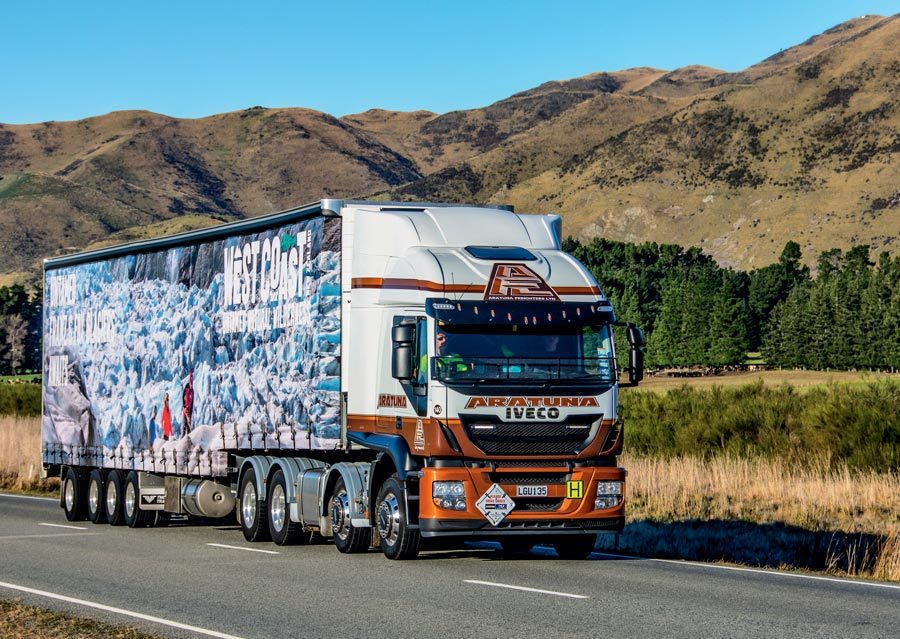
Few places conjure up the hard and tough images of New Zealand life like the South Island‘s wild and windswept West Coast. It‘s a holiday escape for many, but living and prospering here requires a different mettle to the norm. It‘s a place that will test resilience, stamina, tenacity, resourcefulness, and community, repeatedly. Interestingly, it‘s not always the region‘s physical attributes that apply such pressures. Governments capitulating to the whims of the deluded have time and time again pulled the rug out from underneath this hardworking but sparsely populated region, denying them the opportunity to build wealth and prosperity on the back of the hidden bounties contained therein. In amongst all of this the Havill family has succeeded in building Aratuna Freighters Ltd, a successful transport, storage, and freight agency business.
But before we move on to the story proper, there‘s something interesting about trucking on the West Coast – IVECOs. Six of Europe‘s big seven trade in the New Zealand market and of that six you‘d have to say that it‘s IVECO that more often than not struggles to retain a front of mind position around the capex tables of Kiwi trucking operations when considering a premium European truck – and the question we often ask is, why?
Interestingly, where that sentiment doesn‘t hold true is on the South Island‘s West Coast, one of the country‘s toughest regions, where many carriers contend daily with what is arguably the nation‘s most formidable sealed carriageway, Arthur‘s Pass. You could argue the West Coast is an IVECO stronghold, and we all know that getting a Coaster to buy something they don‘t want to is akin to trying to rent a Chevy to Henry Ford. Aratuna Freighters, T Croft, Birchfield Coal, Henry Adams Contracting Ltd, and Arnold Transport Ltd are all West Coast firms running IVECOS in their fleets. Second generation and current general manager at Aratuna Freighters Andrew Havill cites the support they get from NZ Trucks Ltd, and IVECO‘s sales consultant Straun Syme as being key components of their own IVECO story. “ They‘re not the best at anything, but they ‘re great at everything. They ‘re not the most powerful, lightest, or the most fuel efficient, but the average of all the key figures, their price, and the aftersales we get, makes them a bloody great truck. Most of ours have run to 1.2, 1.4 million kilometres with no issues beyond the norm – ser vicing and consumables, the odd turbo. Even the Cursor 10 460 has been an outstanding engine to us. The bottom end in them is really strong.”
That road – State Highway 73
When speaking of the Coast ‘s IVECO fraternity, it‘s probably Aratuna Freighters and T Croft who aim their IVECOs at Arthur‘s Pass the most. The three alpine passes – Lewis, Arthur‘s, and Haast – form the main routes out of the Coast. In the event Mother Nature‘s shut the door on them, there‘s north and east up the Wairau Valley, or even more of a detour, over the Hope Saddle and out through the Whangamoa Saddle east of Nelson. Those last two pretty much comprise the ‘It must get through at any cost ‘ options. Of the three passes Arthur‘s is the gnarliest on account of the topography, climate, and elevation, with Lewis the most docile and Haast somewhere in-between, but leaning more toward gnarly than docile. Arthur‘s is the most direct route to the Queen‘s city from Greymouth and Hokitika, taking an hour less than the Rahu – Lewis option.

It‘s come a long way over the years. The viaduct ended the era of splitting B-trains to get through the zigzag, but it in itself is by no means a cakewalk. Even in New Zealand you won‘t see too many places with a 16% gradient sign like the one on the summit at the top of Pegleg. The list of iconic and infamous sections along this tortuous route is endless, and places like the Cribb Wall, Waimak Bluffs, and Craigieburn cutting, join Pegleg and the viaduct as trucking landmarks on a quest to break those operators attempting to conquer them daily. Troy Gaulter is the driver of Aratuna‘s latest IVECO and is one such warrior taming Arthur‘s Pass almost every working day. He‘s a native of the Coast and has been with the company for nine years. His latest ride is a Stralis 8×4 AT with a Cursor 13 motor and IVECO EuroTronic AMT transmission. It tows a TMC Super-Quad refrigerated curtainsider semi. We learned a lot on our day with Troy, not least if you‘re going to tame a beast with infinite might like the Arthur‘s Pass, best not to attack it like a maniac with all guns blazing, rather glide through its patch without it knowing you‘ve even been there. That ‘s exactly how Troy treats the pass, and everyone on the test that day witnessed it, with comments like, “My God he was easy on that thing. What a superb display.”
The balance sheet of ascending and descending
When you think about it, the great mountaineers are never hulking brutes with bulging guns and thighs. Ed was tall, but he was a beanpole. Likewise, Aratuna chose the Cursor 13 as the right mix of power, weight, and economy for its daily run to Canterbury. With the 15.6m Super-Quad in tow on eight axles overall, the unit is HPMV rated for 48 tonne on SH1, and 46 on the pass. With a tare of 19 tonne Troy can drag 27 tonne backward and forward with a power-to-weight ratio of 10.9hp/tonne, so by anyone‘s reckoning this is a well thought out, productive lorry.
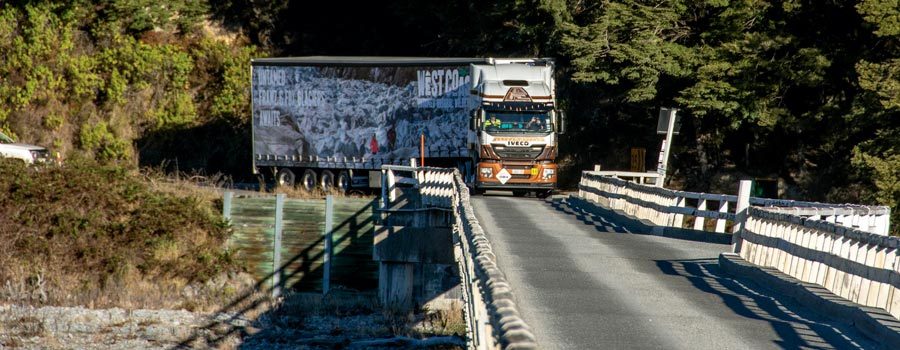
Photo: The turn onto the Bealey bridge. One of the spots Troy said can‘t be taken lightly.
“ The Powerstar is a bit too heavy and thirsty for our application. The 500‘s just right,” said Andrew Havill.
Under the cab is the well-known 12.9-litre Cursor 13 motor in Euro 5 trim via SCR. It‘s an overhead cam unit with highpressure direct injection, four valves per cylinder, and a variable geometry turbocharger. IVECO says this is responsible for delivering high torque values over a wide engine range. Let ‘s see.
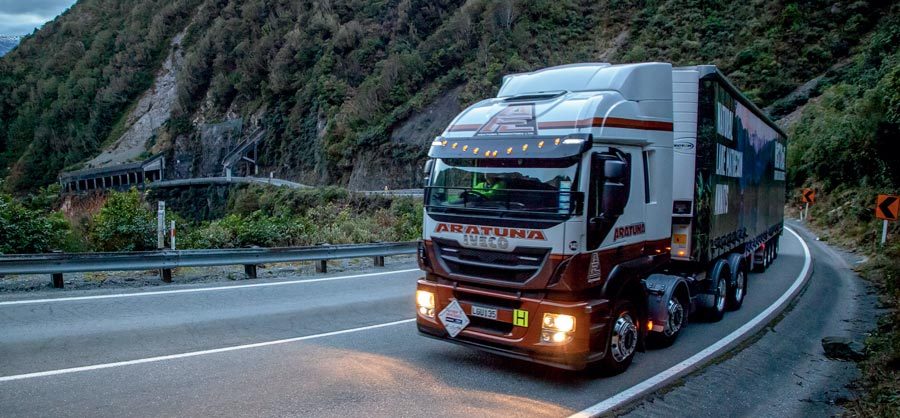
Photo: Wrestling in the teeth of the beast again. Troy on Candy‘s Bend between Rock Shelter and Pegleg.
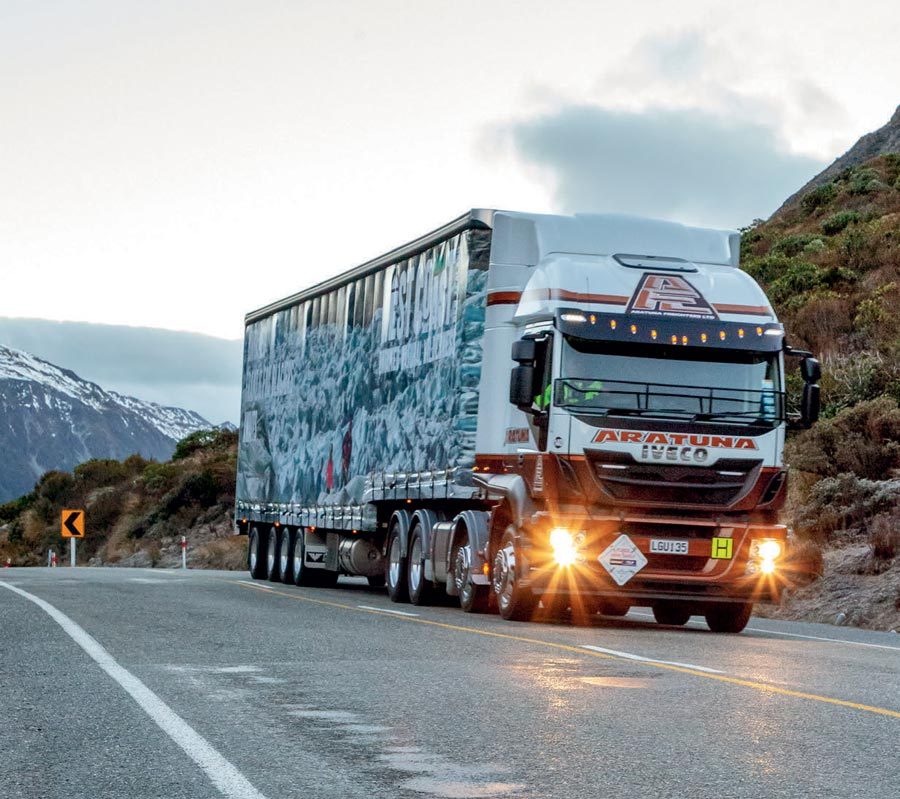 Photo: Conquered again. The key to it is patience.
Photo: Conquered again. The key to it is patience.
Peak power is 373kW (500hp) and that arrives at about 1550rpm, very handy! The top torque figure of 2300Nm (1696lb/ft) sets off at 1000rpm and shows no sign of departure until 1500rpm. So, both critical numbers handshake and wave goodbye to each other when they ‘re both almost at the top of their respective games. Power‘s just a hair off its peak as torque departs. That should and certainly does result in a willing heart beneath the floorboards. It‘s a typical contemporary European power/torque performance profile, very PACCAR MX-ish. Behind the burner is the two-pedal IVECO EuroTronic II 16AS630 TO AMT transmission (read ZF AS-Tronic). Front axles comprise a pair of IVECO 5876 rated at 13 tonnes combined, sitting on IVECO load equalising four-airbag, parabolic spring and shock absorber combo. (You can have it all.)
Looking aft there‘s Meritor RT46-160GP axles rated at 20.9 tonnes with driver-controlled diff locks. They ‘re sitting on Hendrickson PRIMAAX PAX 462 suspension. GVM and GCM are 31 and 75 tonnes respectively.
In the ancillary stopping department there‘s IVECOs twostage engine brake, and brake-wise Knorr disc brakes furnish the front end, and at the back drum brakes with auto slacks. There‘s WABCO E 4-channel ABS/EBL (Electronic Brakeforce Limitation), and ASR (Anti-Slip Regulation). The truck‘s shod with 295/80R 22.5 tyres on polished Alcoa alloy rims. So there you have it. A mountaineer, Aratuna style.
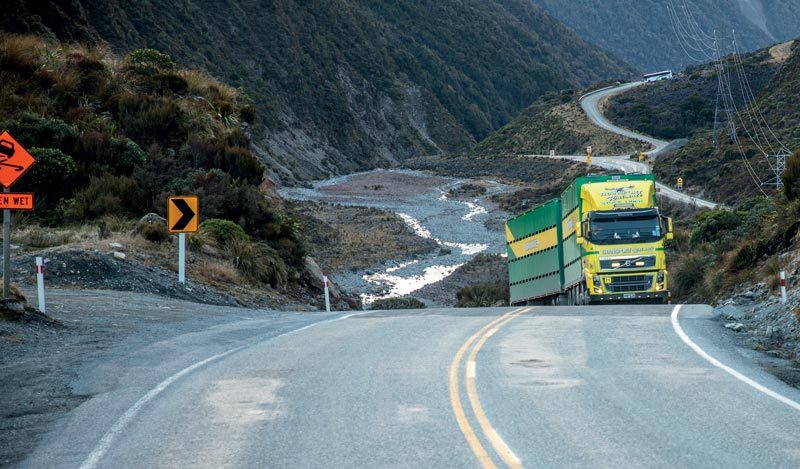
Photo: Heading back west the severity of the drop off Pegleg is plain to see.
Welcome to our place
Climb into the IVECO and you‘re entering a world individual to them. There‘s no immediate “Oh yeah it‘s a … in disguise”. We jumped in on the side of the road in Hornby. Troy had just left his last pick-up and there was no time for mucking around, we were in and gone – that answers access. It‘s a four-step entry and it‘s not a high cab, we‘re not talking flat floor here – so getting into it is super easy. There‘s a full-length grab handle on the A pillar and another smaller one on the B. The steps cascade between two, three and the cab floor so it‘s as safe as houses if safety gone mad has cost you your balance and agility.
Once inside you think “Oh yeah. This is cool.” It‘s a cavernous cab with a ‘snug‘ feel if that makes sense. Like we said it‘s not a flat floor but still has a pull-out thermal drawer that‘s sort of under the bunk and a caddy next to it for knickknacks – ideal for drink bottles. Troy thinks they should do the fridge and we‘ll take his word. Who are we to argue when we don‘t hammer it around every day. The thermal drawer is still cool though, and better than just another drawer or locker. The floor hump with drawers means the bed is higher than normal – no problem there. Standing room is a given. Troy‘s not a whopper by any stretch, but six-footers will be able to stand up and sort themselves out too.
Storage is everywhere, with two layers front and overhead, a row of lockers with doors on top, and netted trays underneath. There‘s also stowage on the sleeper‘s upper sidewalls and under the bunks, accessible from the outside. Fit and finish-wise there‘s not a squeak or creak to be heard and Troy said based on his experience with the brand, it‘ll stay that way. There are darker toned plastics, hardwearing vinyls, rubber and the like in the lower flanks, with lighter tones above. Like most big Euros there‘s a world of dampening between the driver‘s chuff and the black-top. The cab‘s on four feet with air suspension and dampers at rear. Don‘t forget the other layer of air in the front suspension also, as well as springs, driver‘s seat, etc.
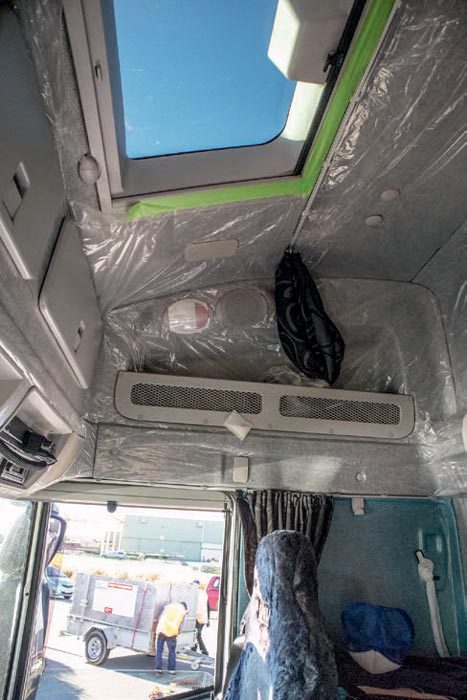
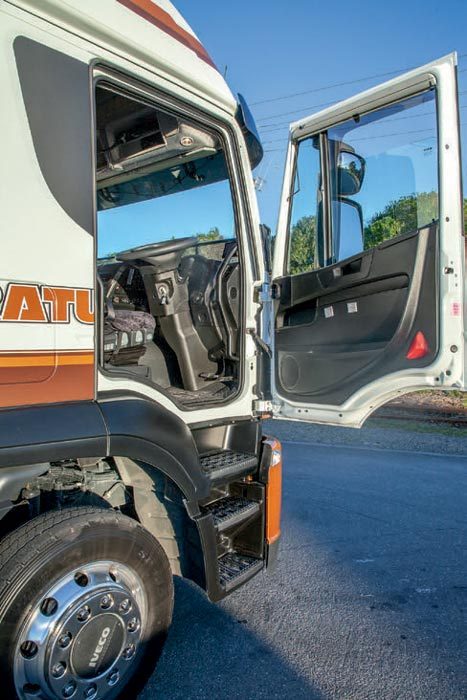
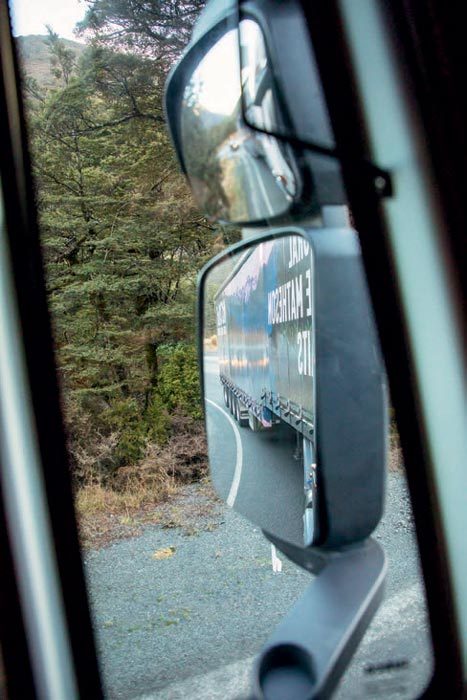
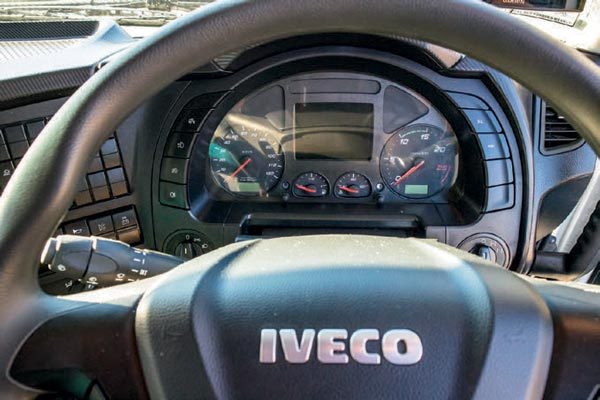

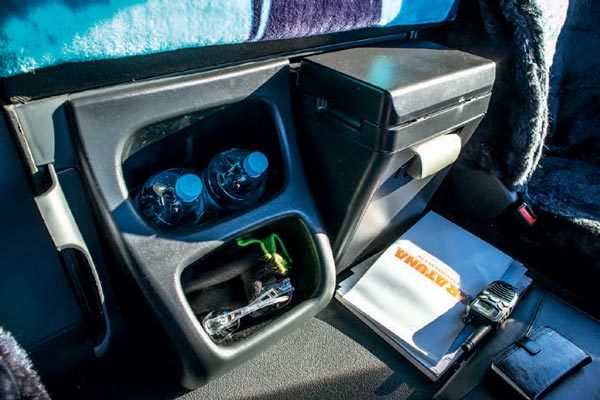
Photos: A clear binnacle and swish little wrap. An easy place to live where everything falls nicely to hand. A useful caddy with a thermal drawer. Great mirrors are essential on this work even though the TMC Super-Quad behaves impeccably. Plenty of steps and grab rails as well as a nice cascade at the top. The steering wheel is only needed for steering in this truck. Plenty of standing room.
Because of the wee hump in the floor, the drawers and caddy under the slightly elevated bunk, and the wrap in the dash, the driver‘s berth has a real cockpit feel to it. But there is no issue space-wise when Troy needs to prepare for a session of fatigue management in the bunk, or should he find himself needing to exit via the left door. Attention Fuso, UD, and to a lesser degree Hino and Isuzu. This is how you build a not so high, slightly forward control premium cab. If we were an operator with a good feel for what the driver needed, and had our final list of contenders in front of us, this could be the clincher. Back to the driving department. It‘s a great position with a typical Euro binnacle, light on gauges, high on warning lights, with the vehicle and trip metrics screen centrally located. There are buttons either side of the binnacle and the small integrated wrap is within easy reach, with a large central block of buttons (mostly blanks); the buttons on the far left-hand end of the block are in silver and comprise the transmission control. Beneath them are more buttons and climate controls. The left wand is the all-in-one indicator, dip, windscreen washer, wiper control, and the right is the engine brake, cruise control, and manual gear change (pull for up a gear, push for down). There‘s nothing that‘s not ‘right there‘. There‘s no entertainment, navigation, or data screen, and the radio is overhead which is bit ‘yesterday‘ now; however no fear, that‘s all been sorted on the Euro 6 model when it arrives. There‘s a big skylight in the roof for Vitamin D supply and plenty of man-made light when required. The mirrors are large and plentiful with all modern safety extras, and visibility when clearing left and right is fine with a bit of double-checking.
With front under-run protection the Stralis is typical Euro in looks. If you like the others you‘ll likely enjoy the Stralis‘ face peering at you in the early morning as you walk toward it. If you‘re an Argosy, K200, or 9870 boffin, there‘ll be an adjustment period and some counselling involved. All in all, a room with a view, fit for a King.
Coast to Coast
The Aratuna Freighters story starts in the early 80s when Andrew‘s father Durham saw the deregulation of the transport industry as an opportunity to branch out and diversify from the family‘s farming operations.
The name Aratuna came from combining the names of their two farms, Arahua and Awatuna.
“I think it was a good idea,” muses Andrew. “Some days I‘m not so sure,” he laughs.
With a combination stock truck and tipper, they‘d carted their own cattle to and from the farms, and so the early transport enterprise was mostly centred around rural and regional support. “Everyone‘s local, you might say.” As time went on freight volumes crept up and a regular profile would see timber or stock heading east from Hokitika and fert or freight coming home.
“We started getting traction on the freight with the likes of Burnetts and Mainfreight.”
A restructuring at BP provided the opportunity to be a regional distributor. The Havills had the land for the tank and felt they could do it with one less truck. It‘s a contract they hold to this day, the longest standing private BP distributor in the country, with four trucks running under the Aratuna Fuels banner.
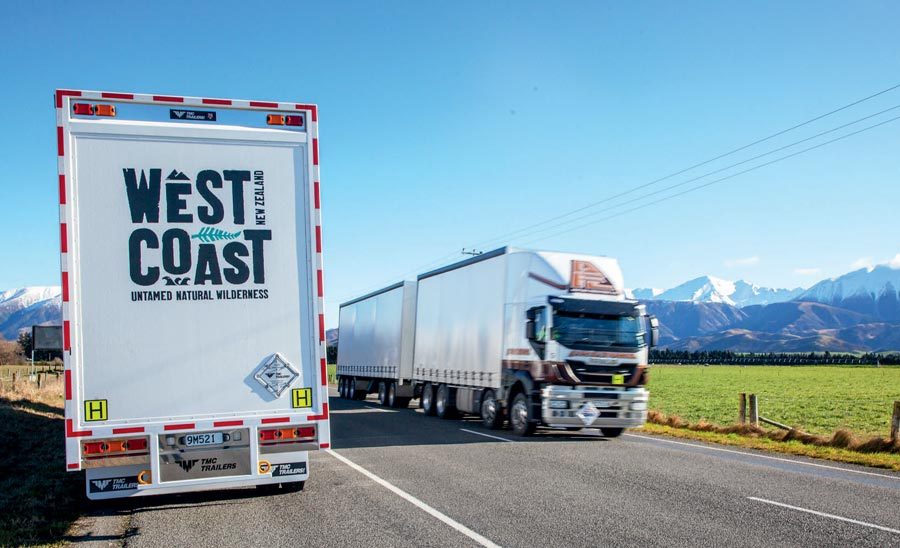
Photo: Two Aratuna Freighters trucks pass on SH73. A scene that repeats itself thousands of times a year, at all times of the day and night.
The early 90s saw an internal restructure, the company consolidating back to three trucks, a curtainsider unit, a fridge unit, and a tanker, the bulk of the freight arm going to TransWest Freighters.
From there a strategic path and organic growth has seen the company steadily grow to the point where today the fleet comprises 50 trucks, 30 of which sport the IVECO badge. “We got our first IVECO in 2004. We‘d had a mix up until then, European and Japanese, including Volvo, DAF, and Isuzu. The Japanese gear was good but what you gained in purchase price you lost in fuel consumption and parts,” said Andrew. “We didn‘t have that good a run from anything really. Straun [Syme – IVECO] had been calling for years and was keen to get one in here. We gave IVECO a go and haven‘t looked back. The key‘s been the support from NZ Trucks. There were a couple that had issues with the heads at one point, but they were on it straight away. They‘re an often overlooked truck but I would have no trouble recommending them at all. They‘ve been great machines to us.” There‘s no question the West Coast is a place where opportunity can‘t be passed up. Today the farms are gone, and Aratuna Freighters Ltd employs more than 70 staff. Services include general and refrigerated freight to pretty much anywhere you like, container sideloaders, and those stalwarts of the company, rural support and the fuel distribution for BP. They hold the local franchise for Mainfreight, the Fastway Couriers agency, and own and run a Ballance Fertiliser store. They are the current holder of the Mainfreight franchisee of the year award.
Forty-seven-year-old Andrew and wife Monique have two children; Lachlan who lives in Germany and works as a forensic accountant, and daughter Ashleigh who is nursing. Company founder Durham Havill is still actively involved in the company, with Andrew in charge of the day-to-day business and Monique running the bulk fuel operation. Durham has served as Westland mayor, receiving an ONZM for services to local government in 2017.
The Havills are a family passionate about their region, and their company. Like nearly all Coasters they‘re modest and humble when discussing their achievements. “It‘s a tough game, especially here, but we keep to our work and the others keep to theirs,” says Andrew. “We don‘t all go getting silly about it. You can‘t on the Coast. At some level we all have to work together.”
And that‘s a lesson the rest of the country could well do to take on board.
A passion for trucks
“I‘ve done a lot of things but I‘ve always had a passion for trucks and driving them,” was Troy Gaulter‘s summation from the driver‘s seat of fleet number 140.

Photo: Troy Gaulter just has a passion for trucks, simple as that really
Troy, 48, is a ‘Coaster‘ from birth, his Dad Bill worked in the forestry and Mum Heather was a nurse. “They‘re both in Aussie now. Have been for twenty or so years. I probably would be too, but I want to be close to my two girls so I‘m here for the foreseeable. I enjoy the Coast, surf-casting and that. It‘s home. It‘s quiet.”
‘My, what big teeth you have‘
Rolling west from Christchurch it‘s about as docile as trucking can possibly get in New Zealand. Long straight roads cut through paddock after paddock of some of the country‘s finest farming turf. From Rolleston we pick up State Highway 73 between West Milton and Kirwee. The Stralis is loaded with 24 tonne of product bound for the Westland Dairy facility in Hokitika. It‘s both a regular pick-up and drop-off point for Troy. We‘re three tonne under what the truck‘s legally able to cart, but probably representative of a good average considering general freight trucks rarely run to max GCM one hundred percent of the time. It ‘s certainly enough to give the Cursor a workout.
The run up (literally) the Benmore straight to the foot of Porters Pass is a doddle, and the volume of the conversation in the cab wouldn‘t raise the ire of even the most prudish of librarians, the sound meter hovering in the upper mid-60 decibels. At 90km/h the Cursor is ticking along at 1450rpm. Again, it‘s very PACCAR MX with a lovely throaty note that, like the D utchman, tricks you into thinking there‘s something of greater displacement beneath the floorboards. Talking interior, it‘s nice to be sitting in a cab that doesn‘t fall under one of the big identifiable platforms. This is IVECO‘s way of doing things in high style, and Troy explained how we came to be riding in the high roof AT option.
“ The original truck was a flat roof sleeper but it was affected by the bug boat thing in Auckland and ended up back in Australia. Andrew needed a truck ASAP and this was the only one they had. It‘s fine by me,” he laughed.
It ‘s a handy asset too. Although Troy ‘s home most of the time, the Aratuna trucks can go further afield depending on customer requirements, even north of the ditch at times. “ The cement boats couldn‘t get into Onehunga at one point so we were carting up there from Westport. You just never know. No, I‘m certainly not complaining about having this sort of space.”
Before you knew it we were into Porters Pass. Unlike Deane Harris in the Hobbs and Banks Stralis a couple of years ago, Troy takes control of the transmission once the table top Canterbury Plains are a memory.
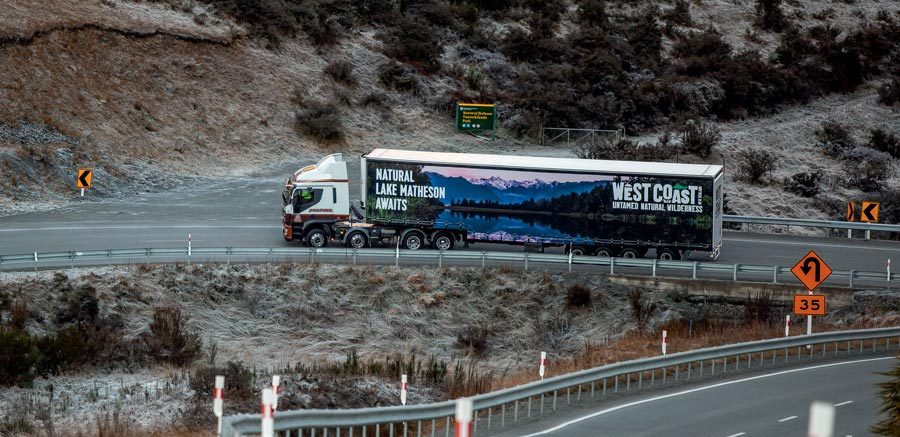
Photo: Heading east at the bottom of Porters Pass.
“It‘s just easier on me and the truck on this road. There‘s too many shitty bits that cause the engine to lose out you know? I know all the shift points and where it gets nasty. Coming over from the other side I just put it in the climbing gear at the bottom below the rockfall and let her go.” Having said that, he‘s adamant his days of stirring gear levers are hopefully gone, converted fully to the AMT. “ W hy would you? Look, you‘re not busy swinging on gear levers and all that. I can sit here and move the paddle in the right spot and the truck does the rest. It‘s stress-free. No, I wouldn‘t go back by choice. All right if that ‘s what you had to do, but no, not by choice.”
Up around the infamous Cribb Wall and the IVECO‘s in 7th gear, 1650rpm and 23km/h. The Crib‘s the steepest section westbound and there are no guesses for east. Troy said full weight on the Otira Viaduct and Pegleg the Stralis is down to 6th gear, 1800rpm and 17km/h.
With the Craigieburn cutting and the beautiful Lake Pearson behind us, Troy worked his way cautiously along the Waimak bluffs toward the Bealey Bridge. “ They bloody come around here on the wrong side of the road, it‘s unbelievable. You‘ve got to be able to just stop!” said Troy about the narrow Waimak bluffs. A hard right-hander onto the postcard bridge and onward toward the pass.
“ The road‘s not what it was. They ‘re super cautious nowadays with safety and all that. If a cloud appears in the sky they close it,” he says and the cab fills with laughter. “ The CMA and grit they put on does a great job. They get it on early now, and then re-treat it in the early hours before dawn and it makes a huge difference.”
Having said that, we rounded plenty of corners that hadn‘t seen ‘big yellow ‘ for a few days. Any relaxing of the attention levels is not recommended.

Photo: On the top of the pass at the Crib Wall heading home.
Over the summit of the Arthur‘s Pass, past the monument and down the infamous Pegleg, viaduct, rock shelter, down around and over the Yorky Point bridge. In the cab and revs are up, the gear is low and Troy lets the engine brake – stage two – do most of the work, with an occasional feather on the left pedal to keep proceedings under control. There are plenty of axles and plenty of brakes in the modern truck, but this is not a place to mess with. Arthur is never your friend.
Troy said the two-stage engine brake on the truck, while adequate, certainly isn‘t the truck‘s strongest point and says it ‘s the one area that could be improved. It results in an extra cautious, old school approach to places like the viaduct, but that ‘s Troy‘s approach to the whole road anyway. Standing on the outside of corners below the viaduct and rockfall, waiting for Troy to come down, the New Zealand Trucking team were astounded at the red hot brakes, stink, and sometimes even smoke coming off campers and even car traffic as people roared by, utterly oblivious to the demands of the road and the vehicle‘s marginal ability to compensate for their incompetence, ignorant in the bliss that the ‘modern safety features‘ in their jalopy would see them right. Troy on the other hand, glided into view, the Stralis looking and sounding unbothered, and the only smell was the fresh air in their wake. In last month‘s test on the WPBH Kenworths we talked about any mistakes made on the awful roads around Auckland‘s rural fringe resulting in a potential paddock encounter. Get it wrong here though, be it car, camper, or truck, and the implications are in a different league entirely.
The grime squad
Of course one of the scurges of the pass and everything it takes to maintain a status of ‘open‘ is the constant battle to keep the Aratuna trucks looking their best. Sleet, snow, rain, dust, grit and CMA wage war on the company‘s desire to maintain a sharp image, but Andrew said the recent purchase of a hand-operated truck and curtain wash machine from Transport Wash Systems has been a game changer. The walk behind full height washer keeps the day-to-day grime at bay in a busy week.
“It‘s a great system; a 200L drum lasts 90 hours. Ash Scott‘s been good to deal with. I‘d recommend it,” said Andrew.
IVECO – What‘s in a name?
What about a quick recap on the IVECO name? The Industrial Vehicle Company is based in Turin and was formed in 1975 as the result of a merger between Fiat (Italy), OM (Italy), Lancia Special Vehicles (Italy), Unic (France), and MagirusDeutz (Germany). Since its inception IVECO has continued its expansion, acquiring Ford Trucks UK, Astra (mid-80s), Seddon Atkinson UK (1991), and International Trucks Australia Ltd (1992). IVECO has been an innovator in many areas, including emissions and alternative fuels.
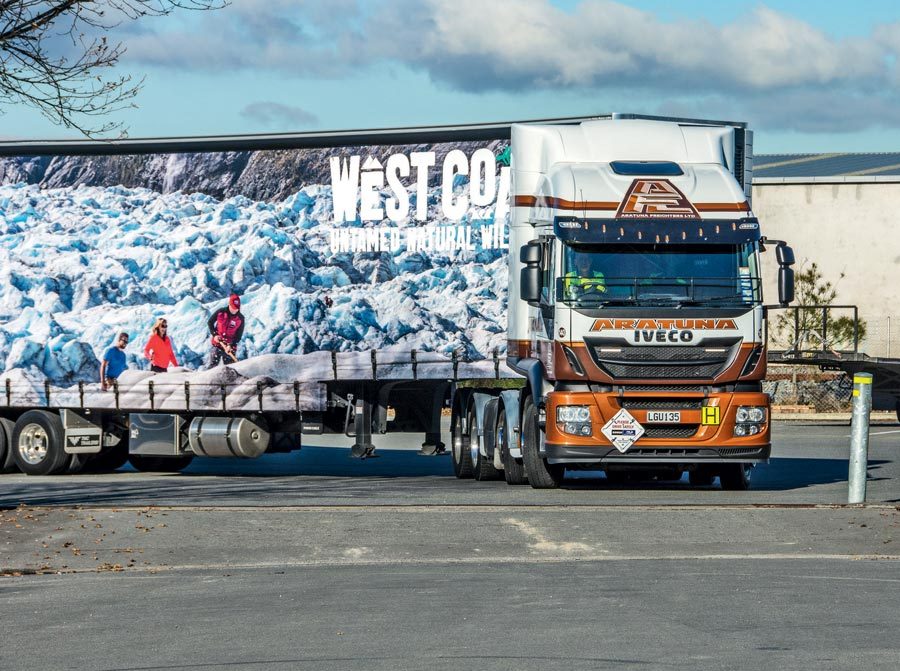
Photo: Burning around Christchurch it‘s hard to appreciate where the Stralis will be three hours hence.
Today IVECO forms part of the colossal CNH Industrial Group and is generally accepted as one of Europe‘s big seven truck manufacturers along with Volvo, Mercedes-Benz, Scania, DAF, MAN, and Renault. IVECO has manufacturing plants in Europe, Russia, South America, Australia, Africa, and Asia, producing 150,000 vehicles annually.
IVECO Trucks New Zealand was formed in 1992 following the purchase of International Trucks NZ (in receivership) by International Trucks Australia Ltd. The entity traded as International Trucks New Zealand until 2000 when it was changed to IVECO Trucks New Zealand. Today the Dandenong assembly plant in Melbourne builds the Powerstar, ACCO, and Stralis models and is home to a large product engineering department building and testing prototypes specifically for the local Australasian markets. IVECO Trucks New Zealand is able to reap the benefits of the parent company‘s investment into its Australian manufacturing capabilities as well as being able to source products from other factories throughout the world to meet their market needs
How‘s the serenity!
Another classic line from The Castle, but hugely applicable in this instance. “ There‘s absolutely no point rushing on this road,” said Troy. “It ‘ll get you nowhere. The broken jackshafts and collection of wreckage at places like the Crib and Pegleg says it all. They roar in and try and change down and ‘bang‘, she‘s all over. And look! It‘s the most beautiful truck-driving job in the country. Just get in the climbing gear early and enjoy the scenery.” Of course, Troy ‘s on the money. The scenery is breathtaking and there‘s a calmness outside on this blue sky winter jewel of a day that lures you into a false sense of ease and comfort. Inside the cab you wouldn‘t think for a moment Troy and the Stralis have only been partners for a little over a month.
Good and bad drivers are like good and bad horsemen or stockmen. Some thrash their charge into submission – and the vet bill is horrific. Some drive it well but hard – and the vet ‘s number is on the wall by the phone. Some seemingly encourage their steed to do what they want, achieving things in the same time as everyone else, and the vet is someone they met once but can‘t remember his or her name. Troy ‘s a member of the last group, the Stralis seemingly rolling along with the contours of the land. This truck‘s never going to ‘poke the bear‘ so to speak, and entice the Arthur‘s to bite back.
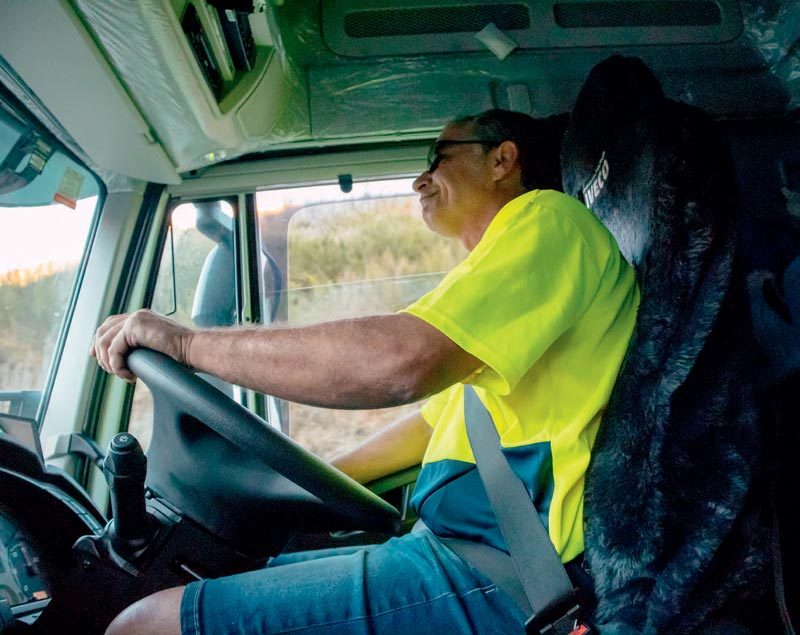
Photo: Troy at the wheel of the Stralis. “There‘s absolutely nothing wrong with them, they‘re a beautiful truck. If I was buying a truck I‘d buy one.”
Once on the other side of the Yorky Point bridge is a classic ‘chase the river to the sea‘, the blueprint for so many Aotearoa roads. Following the Taramakau River out to Kumara Junction it‘s a different landscape entirely from the one on the other side of the alps, a wilderness less tampered with. The road follows the contours, it‘s narrow in places, but after the preceding fifty or so kilometres, far less intense. An interesting figure in the life of an Aratuna truck would be average speed. High-speed cornering is probably not going to be a standout feature, but like a truck on the East Cape, Northland, Coromandel, Catlins, or eastern Wairarapa, the amount of cornering will be right up there. Inside the cab the Stralis was firm and stable on its load-equalising airbag and spring front end setup, not in the least bit wallowy. There was no perceivable ‘encouragement ‘ from the trailer, so often a trait of the tractor–long semi union. Aside from driving style, having the surefootedness of an 8-wheeler up front is certainly implicated in the lessoning of the trailer‘s influence, as does steering on the trailer itself.
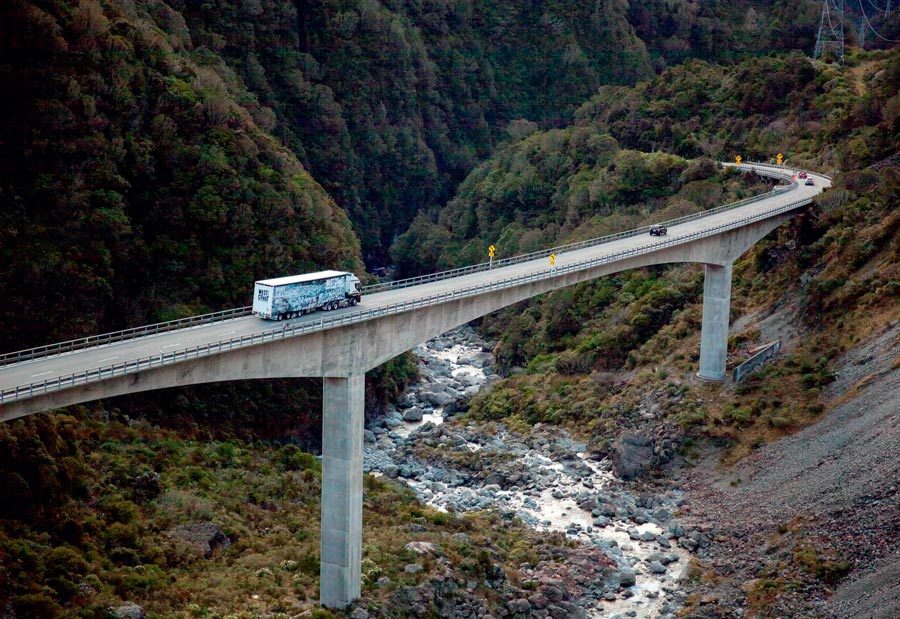
Photo: As challenging as it often is, this is surely one of the great truck corridors.
Speaking of trailers, the TMC Super-Quad is also brand spanking new, with curtain graphics advertising the beauty and splendour of the West Coast. Aratuna has a second reefer unit in the promotional livery and T Croft in Greymouth and Westport‘s Johnson Brothers have units painted too. The trailer is set up on ROR CS9 disc-braked axles on air suspension and with polished alloy wheels, stainless toolboxes, and Hella LED lighting; it makes for a spectacular overall look. Back to the front end and Troy affirmed the steering and directional control on the Stralis was unfaultable, as were the brakes. Gone are the days where a lack of steering lock was the trade-off for buying an 8×4. Like the Stephenson Isuzu we tested in March, the Stralis was as nimble as you like in and around industrial Rolleston and a joy on the road. Only a month in and the pre-purchase number crunching appears to be paying off in consumption. Bear in mind the road, eight axles, a hellish climate at times with constant wind, and a work profile that never allows the Stralis any empty running, and 1.84kpl (5.18mpg) looks more than respectable. Although like Toko and Len in X15s last month there‘s a lot of credit to be laid at the driver‘s feet in that figure, we shouldn‘t forget the outstanding results modern diesel engines are able to deliver as a result of their own evolution and the clever people keeping them out in front as the preferred propulsion proposition at the heavy end…for now at least.
Summary
When you‘re looking at the next purchase, everyone looks at who‘s got what, where and why. As is so often the case the West Coast is overlooked by the rest of the country, left to do what they‘ve always done, get on with things. It‘s interesting that IVECO has such a presence on the Coast; in ma
Read more
The right man for the job
0 Comments29 Minutes
Legendary ambition
0 Comments36 Minutes
Hard Fought!
0 Comments40 Minutes





